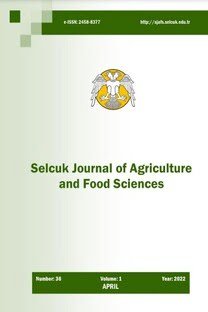GC/MS Study of essential oil from Helichrysum chasmolycicum P.H. davis
uçucu yağlar, Asteraceae, Isparta, endemik bitkiler, endemik türler
Helichrysum chasmolycicum P.H. davis uçucu yağının GC/MS çalışması
essential oils, Asteraceae, Isparta, endemic plants, endemic species,
___
- 1. Afolayan, A.J. and Meyer, J.J.M., 1997. The antimicrobial activity of 3,5,7-trihydroxyflavone isolated from the shoots of Helichrysum aureonitens. Journal of Ethnopharmacology. 57:177-181.
- 2. Başer,, K.H.C., Demirci, B. and Kinmer, N., 2002. Composition of the essential oils of four Helichrysum species from Madagascar. Journal Essential Oil Research 14:53-55.
- 3. Baytop, T., 1984. Treatment with plants in Turkey. Istanbul Univ. Publ. Nu.3255,İstanbul, Turkey, (in Turkish)
- 4. Bianchini, A., Tomi, P., Bernardini, A.F., Morelli, I., Flamini, G., Cioni, P.L., Usai, M. and Marchetti, M., 2003. A comparative study of volatile constituents of two Helichrysum italicum (Roth) Guss. Don Fil subspecies growing in Corsica (France), Tuscany and Sardinia (Italy). Flavour and Fragrance Journal 18:487-491.
- 5. Bianchini, A., Tomi, P., Costa, J. and Bernardini, A.F., 2001. Composition of Helichrysum italicum (Roth) G. Don Fil subsp. italicum oils from Corsica (France). Flavour and Fragrance Journal 16:30-34.
- 6. Cavalli, J.F., Ranarivelo, L., Ratsimbason, M., Bernardini, A.F.and-Casanova, .J., 2001. Constituents of the essential oil of six Helichrysum species from Madagascar. Flavour and Fragrance Journal 16:253-256.
- 7. Chinou,T.B., Roussi, V., Perdetzoglou, D. and Loukis, A., 1996. Chemical and Biological studies on two Helichrysum species of Grek origin. Planta Medica 62:377-379.
- 8. Chinou, I.B., Roussi, V., Perdetzoglou, D., Tzakou, O. and Loukis, A., 1997. Chemical and antibacterial studies of two Helichrysum species of Grek origin. Planta Medica 63:181-183.
- 9. Coşar, G. and Çubukçu, B., 1990. Antibacterial activity of Helichrysum species growing in Turkey. Journal of Ethnopharmacology 57:177-181.
- 10.El-Massry, K.F., El-Ghorab, A.H. and Farouk, A. 2002. Antioxidant activity and volatile components of Egyptian Artemisia judaica L. Food Chemistry 79:331-336.
- 11.Meyer, J.J.M. and Afolayan, A.J., 1995. Antibacterial activity of Helichrysum aureonites (Asteraceae). Journal of Ethnopharmacology 47:109- 111.
- 12.Paris, R.R. and Moise, H., 1971. Matiene medicale. (Vol.3), Pharmacognice Speciale-Dicotyldones-Gamopetales, pp 286, Paris, Mason.
- 13.Ramanoelina, P.A.R., Bianchini, J.P. and Gaydou, E.M., 1992. Chemical composition of the essential oil of Helichrysum bracteiferum. Ournal of Essent Oil Research 4:531-532.
- 14.Ruberto, G., Biondi, D.M., Barbagallo, C, Meli, R. and Savaco, F., 2002. Constituents of stem and flower oils of Helichrysum litoreum Guss. Flavour and Fragnance Journal 17:46-48.
- 15.Walheim, L. 1981. Western Fruit and Nuts. HP Books, Inc. p. 166.
- ISSN: 1300-5774
- Yayın Aralığı: 3
- Başlangıç: 2018
- Yayıncı: Selçuk Üniv. Ziraat Fak.
Konya ili merkez ilçelerindeki sığır besiliciliğine yer veren tarım işletmelerinin ekonomik analizi
UFUK KARADAVUT, SEYİT ALİ KAYIŞ
GC/MS Study of essential oil from Helichrysum chasmolycicum P.H. davis
Mısır makarnası kalitesine bazı katkıların ve hamur ön pişirme metotlarının etkisi
Combining abilities for grain yield and leaf characters in pea parents and crosses
Konya ili ilçesi tarım arazileri için kapitalizasyon oranının tespiti
AHMET TUĞRUL POLAT, Serpil ÖNDER
Bor biriktiren Gypsoplila I., Cinsi bitkilerin moleküler genetik yöntemlerle karakterizasyonu
Erdoğan Eşref HAKKI, Ayşegül ÜNLÜ, Zeynep ÖZBEK, Sait GEZGİN, Mehmet BABAOĞLU
